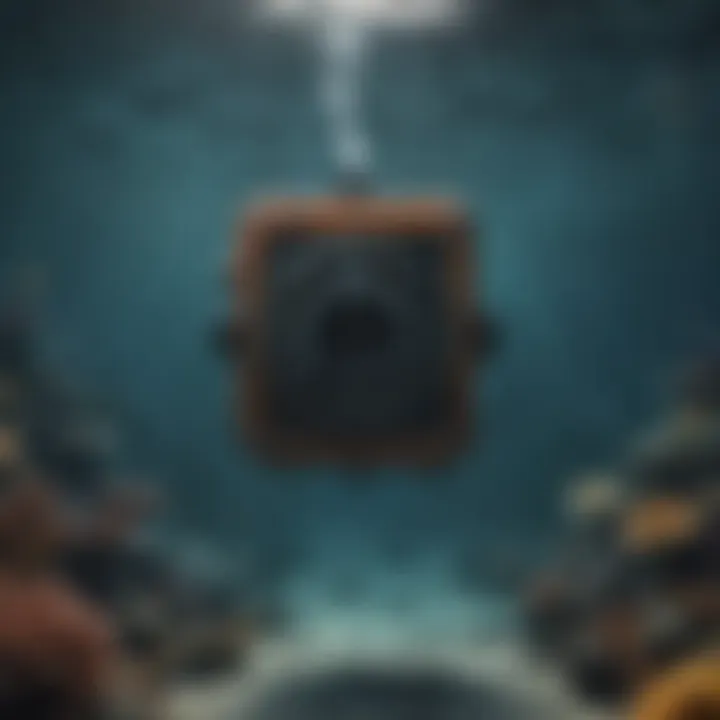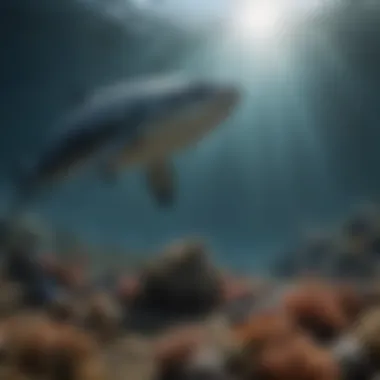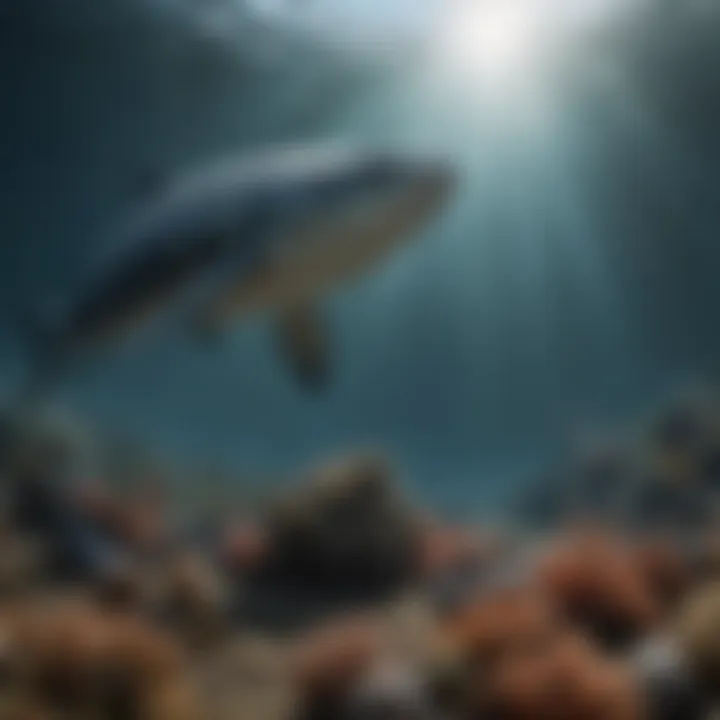Understanding Ocean Noise Pollution and Its Effects


Intro
Ocean noise pollution has burgeoned into a pressing concern, throwing the balance of marine ecosystems into disarray. This issue, often overlooked, encompasses various sources, from shipping and industrial activities to seismic exploration and naval exercises. As sound travels further and penetrates deeper in water than in air, marine species, many of whom rely on sound for survival, face dire consequences. The intricate tapestry of ocean life is now threatened by the cacophony generated by human actions. Understanding this phenomenon is no longer just an academic exercise; it’s a necessity for the preservation of biodiversity.
In delving into the impacts of this pollution, one must first comprehend the basic mechanics—how sound waves are produced, transmitted, and received under the sea. Fish, marine mammals, and an array of organisms use sound to communicate, navigate, and locate prey. When their underwater world becomes enveloped in noise, the fabric of their existence starts to wear thin.
What’s at stake here? Beyond the immediate effects on marine life, there are broader implications for global marine biodiversity, which, in turn, influences ecosystem services that humanity depends on. From tuna fisheries to coral reefs, the repercussions ripple through our oceans, affecting both the biosphere and human economies. This area of study is pivotal in today’s scientific dialogues, fueling discussions about conservation tactics and legislative measures designed to combat the rising tide of underwater noise.
One cannot underestimate the significance of raising awareness about this issue. It is a call to action, not just for scientists, but for policy makers, educators, and the general public to rally together in safeguarding our ocean's health. \n
"The oceans are the world’s lifeblood, and if we are to protect this vital resource, we must start listening to the sounds it makes."
The journey through this topic will uncover the various ways in which noise pollution manifests and its tangible impacts, while also presenting a roadmap for future strategies aimed at mitigating these effects. A well-rounded understanding of the elements at play will arm readers with the knowledge necessary to advocate for sustainable practices that support the health of our oceans.
Preamble to Ocean Noise Pollution
Understanding ocean noise pollution is paramount in the broader context of marine ecology and conservation. The sounds we generate through various human activities permeate the underwater world, potentially causing significant disruption to marine life. Whether it’s from ships prowling the seas or the thumping of seismic surveys, these sounds change the acoustic environment of the oceans in profound ways. Understanding this topic helps to frame not only the technological advancements leading to such pollution but also enforces the need for dedicated efforts in preserving fragile ecosystems.
Definition and Overview
Ocean noise pollution refers to the unwanted or harmful sounds in the ocean environment that are generated by human activities. Typically, this encompasses a range of frequencies and volumes, which may interfere with the natural communication, navigation, and breeding habits of marine organisms.
This pollution can be further contrasted with natural ocean sounds, which play vital roles in marine ecosystems. For instance, many marine mammals depend on echolocation and vocalizations to interact within their species and navigate their surroundings. When human-generated noises obscure these natural sounds, it can lead to disorientation and stress among marine species.
The noise can come from various sources, including shipping, naval exercises, and even recreational boating. Each contributes uniquely to the underwater soundscape, presenting distinct challenges to the survival of marine wildlife.
Historical Context
Historically, the oceans have always been a cacophony of sounds, both natural and anthropogenic. The technological advances that commenced in the second half of the 20th century significantly ramped up noise levels in marine environments. The introduction of larger ships, intensive naval operations, and the insatiable quest for oil and gas has altered the underwater soundscape drastically.
In the 1960s, researchers began to take note of these changes. Studies showed shifts in the distribution of marine species, prompting deeper investigations into the relationship between noise pollution and marine life. By the early 2000s, regulations started emerging to mitigate these impacts, highlighting a growing awareness of environmental concerns. From the establishment of guidelines by organizations such as the International Maritime Organization to ongoing conservation efforts, there has been a gradual push towards understanding and reducing the effects of ocean noise on marine biodiversity.
As the call for stricter regulations and compliance to protect marine environments gains momentum, it becomes clear that recognizing and addressing ocean noise pollution's historical trajectory can help shape more effective conservation strategies in the future.
Types of Ocean Noise
Understanding the different types of ocean noise is crucial for dissecting the broader implications of noise pollution. This section provides insight into the chronic and transient noise sources that contribute to the ever-growing issue of underwater soundscapes. Each type has unique characteristics and impacts, playing a significant role in shaping marine environments.
Chronic Noise Sources
Chronic noise sources refer to persistent sound generated in the ocean. These noises linger in the underwater landscape, resembling a background hum that never quite fades away. Several factors contribute to such chronic noise, including:
- Maritime Traffic: The daily operation of boats, cargo ships, and ferries creates a continuous din. With millions of ships traversing sea routes, it adds to a low-frequency hum that permeates the water.
- Industrial Activities: Oil drilling and seabed mining are prime examples of activities that produce ongoing noise pollution. The machinery employed sends vibrations that travel through the water, affecting countless marine species.
- Coastal Development: Construction projects along beaches and shorelines generate noise, which travels underwater and affects delicate marine habitats.
The continuous nature of chronic noise can disrupt communication among marine animals, particularly species like dolphins and whales that rely heavily on echolocation. For instance, the persistent sounds can mask important signals, leading to challenges in mating, hunting, and social interactions.
Transient Noise Events
Transient noise events are those short bursts of sound that occur sporadically but can have profound effects. These include:
- Military Sonar: Naval activities generate noise akin to an unexpected pop in a quiet room. Sonar operations can create intense sound waves that travel long distances. It’s been linked to disorientating marine mammals, causing them to beach themselves.
- Construction Activities: While some may consider this under chronic noise, specific events like pile driving create quick, loud sounds that cut through the water, disrupting local marine life.
- Natural Events: Even nature contributes to transient sounds. Things like underwater volcanic eruptions or earthquakes can momentarily amplify sound levels significantly.
Such sudden disturbances can send marine animals into a frenzy, causing immediate changes in behavior. Fish, for example, may seek cover or change their migration patterns, while whales could alter their calling patterns in response.
"The ocean is a finely tuned instrument, and noise pollution plays a discordant note that reverberates through its depths."
In closing, both chronic and transient noise have distinctive profiles and implications. Understanding these types is not just about recognizing varying sounds; it’s about appreciating the potential consequences for marine ecosystems. Managing these noise sources effectively is imperative to preserving the delicate balance within marine life.
Major Sources of Underwater Noise
Ocean noise pollution poses a substantial challenge to marine life, and understanding the major sources of this noise is fundamental to addressing the issue effectively. These sources encompass a range of human activities that generate sound, often to the detriment of marine ecosystems. By diving into this surrounding landscape of sound, we can better comprehend the dynamics at play and the implications they hold for marine biodiversity and health.


Shipping and Maritime Traffic
The world’s oceans are highways for countless vessels, from container ships to fishing boats, all contributing to the noise levels under the surface. These ships produce noise through their engines, propeller cavitation, and hull vibrations. Notably, the roar of heavy machinery can reach frequencies that resonate through the water, often drowning out the natural sounds that marine organisms depend on for communication, navigation, and survival.
A few aspects of shipping-related noise include:
- Increased Shipping Volume: The rise in global trade directly correlates with the increase in maritime traffic, leading to a higher frequency of noise events.
- Fixed and Transitory Bearings: Larger ships tend to introduce constant noise whereas smaller vessels might generate intermittent bouts of sound.
- Adaptation Challenges: Marine species, such as whales and dolphins, are struggling to adapt to their changing acoustic environment. This puts them at greater risk for collisions or failure to communicate effectively with peers.
"The ocean's whispers are being crushed under the weight of ships. Our understanding and response to this growing chaos is essential for marine health."
Naval Activities and Sonar
Naval operations serve a critical role in national defense but they come at a cost to underwater soundscapes. The use of sonar — particularly active sonar used to detect submarines — emits powerful sound waves that can travel vast distances. Although designed for practical purposes, the disruptive nature of sonar has profound effects on marine life, especially species that rely on echolocation.
Key elements tied to naval activities include:
- High Sound Pressure Levels: The sound generated can reach astonishing decibels, uprooting auditory sensitivities in marine mammals and fishes alike.
- Stranding Incidents: There are documented cases of mass strandings of cetaceans linked to naval sonar exercises, raising serious questions about the toll of such activities on these sentient beings.
- Disruption of Behavior Patterns: Species affected by sonar may alter their migration patterns, breeding activities, or normal feeding routines, endangering their survival.
Industrial Activities and Exploration
Industrial activities, ranging from oil drilling to seabed mapping, significantly contribute to ocean noise pollution. The sounds associated with these activities arise from machinery, seismic surveys, and construction efforts that disturb the seafloor. Given the essential resources these activities exploit, the balance between necessary progress and environmental disruption becomes a critical conversation point.
Consider the following aspects:
- Seismic Surveys: These employ air guns that generate sound blasts strong enough to be heard hundreds of miles away, affecting entire oceanic regions.
- Drilling Operations: The restlessness of drilling machinery not only produces noise but can also affect the surrounding water's quality, further complicating the lives of marine species.
- Long-term Impacts: The effects of these industrial activities can be long-lasting, often resulting in ecosystem shifts that threaten biodiversity.
In summary, the sources of underwater noise pollution are as diverse as they are impactful. It is imperative that we raise awareness about these contributors in order to foster solutions that mitigate their effects, ultimately paving the way toward healthier oceans.
Effects of Noise Pollution on Marine Life
The ocean, often dubbed the final frontier for exploration, is much more vulnerable than many realize. The effects of noise pollution on marine life surface as a pressing concern that stems from our activities on the land and water. As submarines and large ships plow through the waves, the clatter reverberates far beyond just the physical disturbances. These noise disruptions carry profound implications for marine species, creating ripples that threaten their very existence. In this section, we delve into the multifaceted impacts of noise pollution, shedding light on specific elements that contribute to the overall decline in marine biodiversity.
Impact on Marine Mammals
Marine mammals, like dolphins, whales, and seals, are often characterized by their exceptional reliance on sound for communication, navigation, and hunting. The interaction of these species in their habitat forms a delicate balance, yet this equilibrium is being unsettled by the rising cacophony of human-made noises. The intensity and frequency of sounds generated by vessels, offshore drilling, and military exercises can lead to several detrimental effects on these creatures.
"Marine mammals are essentially the canaries in the coal mine of ocean health; their plight indicates wider issues in our marine ecosystems."
Research indicates that increased noise levels can cause stress responses, disrupt social structures, and even lead to strandings. Disturbances can mask vital sounds such as echolocation clicks used by sperm whales or the songs of humpback whales, impacting their ability to locate prey and mates. The physical consequences linger long after the noise subsides, creating environments where marine mammals are, in effect, shouting into a void.
Disruption of Fish Behavior
Fish, often seen as the foundational block of marine ecosystems, are not immune to the onslaught of noise pollution. Numerous studies depict a concerning narrative; fishes can experience stress responses to loud noises, which may lead to altered behaviors. Changes in their activity levels and feeding patterns pose risks not just to individual fish, but to their populations.
In particular, the spawning behaviors of some species become erratic, as they rely on specific auditory cues that are now drowned out by the relentless hum of boats and machinery. Fish are adept listeners, utilizing sounds to locate mates and understand the surroundings. With these acoustic cues compromised, we run the risk of a cascading effect that endangers the very fabric of marine life.
Effects on Coral Reefs
Coral reefs, often called the rainforests of the sea, stand as a testament to the intricate relationships within marine environments. However, these vital ecosystems also face challenges from noise pollution. Research has shown that underwater noise can affect the locality and health of coral reefs in ways that many continue to overlook.
Coral reefs thrive in harmony with the sounds of their environment, but interference from boats and industrial activity contributes to a decay in this relationship. Fish that rely on coral habitats for shelter and spawning are particularly affected by noise pollution, which disrupts not only their behaviors but also coral health itself. It is well-documented that stresses from noise can lead to increased cortisol levels in fish, which subsequently makes them more susceptible to diseases and affects their growth rates — this feedback loop can decimate populations over time.
In summary, the impacts of noise are felt across the marine spectrum. The relationship between sound and the life of the ocean is a complex web, one which deserves careful consideration as we navigate the future of marine conservation.
Scientific Research on Ocean Noise
Scientific research on ocean noise is a linchpin in addressing the growing concern over underwater noise pollution. Understanding the complexities surrounding this issue is vital for several reasons. First and foremost, comprehensive research helps us quantify the scale of noise pollution and its myriad impacts on marine life. By employing various methodologies for measurement, researchers gather significant data that highlight the effectiveness of mitigation strategies and facilitated discussions around policy changes. Moreover, these studies provide the foundation for future technological innovations and conservation efforts.
Methodologies for Measurement
When it comes to measuring underwater noise, researchers employ a range of methodologies designed to capture sound levels accurately. This is no small feat, as the ocean is a vast and dynamic environment. Common techniques include:


- Passive acoustic monitoring: This approach involves setting up underwater microphones, known as hydrophones, at various depths and locations. These devices capture sounds continuously, allowing scientists to analyze noise patterns over time.
- Active remote sensing: In this method, sound waves are transmitted and reflected off underwater objects. By evaluating the returning signal, researchers can gain insights into marine habitat usage and the influence of noise on these environments.
- Experimental exposure designs: Researchers may conduct controlled experiments where specific species are exposed to varying noise levels. This creates data on behavioral changes or physiological stress responses, which can be critical for assessing impacts on marine life.
Each of these methods comes with its strengths and limitations, requiring researchers to strategically choose the right combination for their study goals. Additionally, as technology advances, new methodologies are continually evolving, expanding the boundaries of what we can learn about ocean noise.
Key Findings from Recent Studies
Recent scientific studies have shed light on several critical aspects regarding the impacts of ocean noise. Among the key discoveries are:
- Communication Disruption: Many marine species rely on sounds for communication, navigation, and finding mates. Excessive noise from ships and industrial activities disrupts these signals, leading to increased stress and decreased reproductive success in species like dolphins and whales.
- Habitat Preferences: Research has revealed that certain marine species are abandoning traditional habitats simply because of elevated noise levels. Fish such as cod and flounder have shown a marked preference for quieter areas, suggesting that noise pollution is influencing not just individual behaviors but larger community dynamics.
- Physiological Responses: Studies have documented physiological stress responses in fish, crustaceans, and even corals due to increased underwater noise. This includes changes in heart rate and stress-related hormones, reflecting a real impact on health and resilience against other environmental stressors.
“Understanding the adverse ramifications of noise pollution is crucial not just for marine life, but also for maintaining the health of our ocean ecosystems.”
Ultimately, these findings underscore the urgent need for continued research in this area. They provide critical evidence that assists policymakers, conservationists, and the industry in developing more effective strategies for noise mitigation and marine habitat protection. The data and insights gained from scientific research on ocean noise pave the way for a more informed approach to safeguarding our oceans for future generations.
Regulatory Framework and Guidelines
Effective management of ocean noise pollution hinges on a robust regulatory framework. Such guidelines serve not only as essential rules but also as a roadmap for achieving sustainable practices in marine environments. These regulations are crucial in coordinating efforts to protect not just wildlife, but the delicate balance of ocean health that supports diverse ecosystems and human communities alike.
International Regulations
An array of international regulations exist to tackle the daunting issue of ocean noise pollution. One prominent document is the United Nations Convention on the Law of the Sea (UNCLOS), which provides a comprehensive framework governing the rights and responsibilities of nations regarding their use of the world's oceans. Among its protocols, UNCLOS underscores the need to prevent and mitigate the potential adverse impacts of activities like shipping and naval exercises on marine life.
Another significant player in this realm is the International Maritime Organization (IMO). This agency has been at the forefront of creating guidelines specifically addressing noise from ships, advising member states to adopt measures that reduce underwater sounds. Some guidelines encourage the adoption of quieter technologies and practices in ship design and operations to lessen noise emissions.
"Global regulations need to recognize the complex interplay between maritime activities and their impacts on marine species, pushing for a collective responsibility among nations."
Furthermore, organizations such as the Convention on Biological Diversity (CBD) have highlighted the need for countries to integrate ocean noise considerations into their conservation strategies. These international accolades aim to foster cooperation and commitment among different nations, creating a collective awareness toward addressing noise pollution in ocean habitats.
National Policies and Initiatives
On the national stage, policies can be highly variable, reflecting the unique marine ecosystems and economic interests of individual countries. For instance, the National Oceanic and Atmospheric Administration (NOAA) in the United States has set forth dedicated marine pollution regulations that specifically address underwater noise, establishing monitoring practices and promoting research initiatives to understand and mitigate these impacts.
Australia has also implemented comprehensive regulations. The Environment Protection and Biodiversity Conservation Act aims to assess environmental impacts and necessitates detailed monitoring of underwater sound levels in sensitive regions like the Great Barrier Reef. This approach not only aids in conservation but also ensures that industrial activities are kept in check to prevent damage from noise pollution.
In Europe, the Marine Strategy Framework Directive (MSFD) provides another structured approach. It obliges EU member states to develop marine strategies aimed at achieving Good Environmental Status (GES) in their waters, thereby indirectly addressing noise pollution concerns.
Mitigation Strategies
The complexities of ocean noise pollution call for a multi-faceted approach in addressing the challenges it poses to marine ecosystems. Remarkably, mitigation strategies serve as a crucial component in safeguarding our oceans against the detrimental impacts of excessive noise. Through innovation and collective efforts, we can foster a healthier marine environment, which directly benefits not only marine life but also human communities reliant on these systems.
Technological Innovations
Innovative technologies have emerged as pivotal tools in the fight against ocean noise pollution. Engineers and scientists have been pushing the envelope, developing sound-reduction technologies that can be deployed in various maritime contexts. One standout example is the incorporation of quieter ship designs that minimize noise emissions through advanced hull configurations and noise-absorbing materials.
Additionally, real-time monitoring systems have been created to track underwater noise levels, providing precious data that can inform regulatory measures and community practices. These systems can alert operators when sound levels exceed regulatory thresholds, allowing them to adjust operations accordingly. The integration of machine learning into these systems further enhances their effectiveness, as they can analyze noise patterns and help to predict future impacts.
Moreover, noise reduction technologies specific to oil and gas exploration are increasingly being adopted, as companies recognize the need to balance economic interest with environmental responsibility. These innovations not only aim to reduce the sounds generated during exploratory drilling but also include methods to mitigate impacts on marine life that could be disturbed during operations.
Best Practices in Shipping and Marine Operations
While technology plays a vital role, human agency cannot be overlooked. Best practices in shipping and marine operations can significantly contribute to mitigating ocean noise pollution. Educating crew members about sound pollution’s consequences can cultivate a culture of awareness and accountability. Some of the notable practices include:
- Speed Reduction: Slowing down vessels can drastically diminish noise levels, hence shipping companies are encouraged to adopt speed limits in sensitive marine areas.
- Route Planning: By carefully choosing shipping routes to avoid marine habitats critical for breeding and feeding, operators can lessen their impact on vulnerable species.
- Sound Mapping: Conducting comprehensive sound mapping prior to operational activities can help identify the most sensitive areas, guiding better planning decisions.
Implementing these practices not only minimizes underwater noise but can also result in economic benefits by improving fuel efficiency and reducing wear on vessels. As research continues to unveil the extent of noise pollution effects, there’s a growing realization that optimal practices are not merely beneficial but necessary for sustainable operations.
"The ocean is not just a source of vast resources; it embodies a delicate balance that requires mindful stewardship."
By embedding these strategies into collective practices, we can strive for more sustainable interactions with our ocean environments.
Public Awareness and Education


Raising awareness about ocean noise pollution is not just a passing fad—it's become a necessity in today’s world. As this issue continues to gain traction, understanding its implications becomes crucial for fostering community engagement and effective policy change. Public awareness serves as the backbone of collective action against a problem that, albeit often overlooked, has dire consequences for marine ecosystems and humanity's relationship with the ocean.
One of the key benefits of enhancing public awareness is that it cultivates a sense of stewardship among individuals and communities. When people grasp the gravity of how noise pollution impacts marine life, such as disrupting migratory patterns of whales or altering fish communication, they begin to feel a personal connection to these issues. This empathy often drives them to participate in local conservation efforts or change their personal habits that contribute to ocean noise.
Furthermore, educational initiatives can play a significant role in shaping the way younger generations view our oceans. Schools, community centers, and even local businesses can host workshops, talks, or interactive events that shed light on the topic. Such engagements empower students and citizens to take ownership of their knowledge, promoting informed discussions that ripple outward in society.
Role of the Community
The community's involvement in addressing ocean noise pollution is vital. Local groups can band together to create awareness campaigns that leverage social media and public events. For instance, organizing beach clean-ups coupled with informational booths can not only help reduce waste but also educate participants about how certain sound practices in their daily activities can contribute to ocean noise.
Groups such as local fishing communities hold substantial power. By advocating for quieter fishing gear and practices, they not only protect their livelihood but also contribute to a more harmonious underwater environment. The exchanges and collaborations between community members can also encourage sustainable tourism, highlighting the importance of preserving beautiful marine areas.
"Community involvement is not merely about participation but fostering a culture of mindfulness towards our oceans."
Engagement through Media and Outreach Programs
Media plays a critical role in shaping public perception. Documentaries, social media campaigns, and podcasts focused on ocean noise pollution can elevate the conversation around marine health. These platforms have the potential to reach broader audiences, stirring interest and patience in complex scientific issues.
Outreach programs targeting schools and community organizations can spread the message further. Educational materials that are visually engaging, paired with relatable narrative stories, can demystify what might seem like a remote issue. Such initiatives could encompass school challenges where students create presentations or videos to showcase what they learn about the impacts of noise pollution and share them online.
In the end, these avenues of awareness work together to bridge knowledge gaps between scientists and the general public. By encouraging a deeper understanding of ocean noise pollution and its impacts, society is better equipped to advocate for change and engage directly with the solutions presented in research and regulatory frameworks.
In summary, raising public awareness and fostering community participation is essential to tackling ocean noise pollution. Educational outreach and multimedia campaigns can form a powerful alliance in the quest for healthier oceans.
Future Directions in Ocean Noise Research
Ocean noise pollution is a pressing issue that needs our immediate attention. As research progresses, it’s vital to discuss the future directions in this field to ensure we protect marine ecosystems. By exploring new avenues in research, we can better understand and mitigate the impacts of these growing noise levels.
Emerging Trends and Technologies
The scientific community is witnessing an evolution in how we approach ocean noise research. Emerging trends are shifting in focus towards innovative technological advancements that can provide crucial insights. For instance, advances in underwater acoustics, such as hydrophone arrays, are becoming more sophisticated. These devices help capture a wider range of sounds and enable researchers to assess noise pollution's intricacies more accurately.
Additionally, satellite technology is also finding its footing in ocean monitoring. With the ability to measure surface conditions and assist in identifying crowded shipping routes, satellites provide a broader context for understanding noise pollution.
Some notable trends include:
- Real-time monitoring: This technology allows scientists to observe noise levels continuously, providing immediate data to aid in decision-making.
- Sound mapping: Charting noise hotspots in oceans helps delineate areas heavily impacted by human activity.
- Biodiversity assessments: Emerging tools that correlate sound data with marine species behavior can illuminate how noise affects species across the globe.
By staying ahead of these developments, we can foster better conservation efforts and promote sustainable ocean management practices that respect marine life.
Role of Artificial Intelligence in Monitoring
Artificial Intelligence is playing a notable part in the future of ocean noise research. It’s amazing how machine learning algorithms can analyze vast amounts of acoustical data, identifying patterns that might be invisible to the naked eye (or ear).
For instance, AI can:
- Automate data analysis: By doing so, it saves researchers substantial time, allowing them to focus on interpreting results rather than merely processing data.
- Predict noise events: AI can model scenarios based on historical noise data and predict future patterns during certain seasons or in specific locations.
- Enhance decision-making: By integrating AI insights into regulatory frameworks, authorities can make informed choices about noise pollution management and mitigation strategies.
In sum, the fusion of AI technology with traditional research methodologies creates a promising landscape for understanding ocean noise pollution. This synergy might be the key to unraveling complex marine interactions disrupted by anthropogenic noise, ultimately leading to healthier ocean ecosystems.
Finale
Ocean noise pollution stands as an ever-growing concern in the context of protecting our marine ecosystems. The implications of this issue are profound, affecting not just marine wildlife but also the health of our oceans as a whole. While the complexities surrounding underwater noise can seem overwhelming, it's critical to distill the importance of understanding and addressing this phenomenon.
Summary of Key Points
In reviewing the various aspects of ocean noise pollution, several key points emerge:
- Diverse Sources: From shipping traffic to seismic surveys for oil and gas exploration, numerous activities contribute to the cacophony of sounds disrupting marine habitats.
- Impact on Species: Marine life, particularly species reliant on echolocation, like dolphins and whales, face significant challenges due to noise pollution, affecting their communication and navigation.
- Regulatory Frameworks: Current international and national regulations aim to mitigate this pollution; however, compliance and enforcement remain problematic.
- Mitigation Efforts: The technological advancements designed to reduce sound pollution and best practices in marine operations can significantly lessen disturbances in vital ecosystems.
- Community Involvement: It's essential to actively engage local and global communities in discussions about ocean health and noise pollution, turning awareness into concrete actions to protect marine life.
Call to Action
As we move forward, it's imperative for stakeholders, including government bodies, researchers, and everyday citizens, to advocate for stronger action against ocean noise pollution. Here’s how you can contribute:
- Educate Others: Share the knowledge you've gained about ocean noise pollution with friends, family, and your community. An informed populace can drive change.
- Support Sustainable Practices: Advocate for and choose companies that prioritize environmentally friendly operations. Ensure that business practices align with noise reduction strategies.
- Participate in Policy Discussions: Attend local forums or discussions related to marine regulations and express your opinions. Every voice matters in shaping policies.
- Engage with Marine Organizations: Many groups strive to combat noise pollution through research and advocacy. Consider volunteering or donating to support their initiatives.
- Promote Innovations: Stay informed about technological advancements related to marine acoustics and noise mitigation. Support solutions that prioritize the health of our oceans.
By recognizing the profound impact of our actions on marine environments, we can work collectively toward securing a quieter and healthier future for our oceans. Ultimately, the responsibility lies with each of us to make waves of change that ensure the preservation of marine biodiversity for generations to come.



